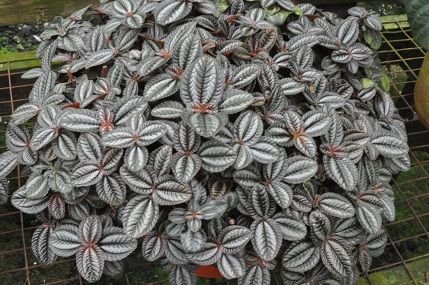Beautiful plants and flowers can make the atmosphere of the room more comfortable and homey. Do you know there are some fantastic Indoor Plants with Black Striped Leaves? Here are some eye-catching images of “7 Beautiful Indoor Plants with Black Striped Leaves” that you can add to your houseplant collection!
Some plants’ stripes may not be completely black, but they may have a dark hue that gives them the appearance of being black or dark from a distance. Let’s check it out!
Black Panimiga

Pilea Ripens, also known as “Black Panimiga” or “Friendship Plant,” has exoctic foliage with dark green and sometimes black leaves. It grows in a low bushy way.
The flowers are very small and appear in flat clusters near the growing tips of the leaf axis. They can be used indoors in medium to low light conditions with good natural air circulation/ventilation.
Ripple Peperomia

Emerald Ripple peperomia is another name for Peperomia caperata. Richly veined ruffled dark green heart-shaped leaves. The peperomia ripple is a herbaceous perennial native to the rain forests of South America’s Brazil. It is a member of the Piperaceae family.
The compact plant thrives in part shade. It has low maintenance requirements and moderate water requirements. Peperomia caperata Rosso are best suited as a small houseplant or an office plant. They make fantastic terrarium plants.
Peperomia Turboensis

Peperomia turboensis is a lovely South American species. The dark green leaves have metallic stripes that glitter in the right light. The leaf undersides can be almost burgundy in color. This peperomia thrives in terrariums.
This species prefers very moist soil as well as a high humidity environment for its leaves. Petioles, which can grow to be up to 5″ long, support the leaves. The leaves can grow to be about 3″ in diameter.
Begonia Cracklin Rosie

Begonia has over 2,000 species, and horticulturists have created even more varieties by cultivating all different shapes and colors! They are native to tropical regions all over the world, but they are also found in homes in cold climates.
Begonia Cracklin Rosie prefers dry soil between waterings and should be watered on a regular basis. Begonia Cracklin Rosie may struggle to thrive and drop leaves if not given enough sunlight. To maximize growth potential, place it less than 3 feet from a window.
Peacock Plant ‘Calathea Makoyana’

The Peacock plant, also known as Calathea makoyana, is a lovely tropical houseplant with contrasting green and purplish-red leaves that will brighten up any indoor living space. Calathea makoyana requires bright, indirect sunlight, temperatures ranging from 60 to 75 F (16 to 24 Celsius), and high humidity.
Water when the soil surface begins to dry, fertilize every 2-4 weeks with a dilute, balanced fertilizer, and pinch back the stems to create a fuller, bushier plant.
Earth Star Bromeliad

Cryptanthus bromeliads, also known as earth stars due to their rosette-shaped leaf arrangement and low growth habit, are beautiful and incredibly diverse plants native to Brazil. Within the Cryptanthus genus, there are over 1,200 different types of bromeliads with a wide range of foliage.
Their colors range from dark green to bright pink to red, and they can be banded, spotted, solid, or any other pattern you can think of. Cryptanthus species, like most bromeliads, are grown for their interesting leaves, but they also produce small but lovely white or pink blooms.
However, the plants only bloom once before producing offsets (pups) and dying. Plant bromeliads outside in spring or summer if you live in the right zone.
Begonia Pearcei

Begonia pearcei, on the other hand, is unique in that it has both attractive foliage and flowers despite being a tuberous Begonia. The velvety, dark leaves have prominent white venation. The flowers are a bright yellow that stands out against the foliage (but it’s relatively rare).
Source: https://www.homiful.com







